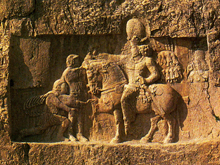|
|
|
Iran's
Transport Ministry forced to divert rail line away from Naqsh-e Rustam
Payvand.com
The decision was taken on Monday during a session attended by officials of the Fars Governor General’s Office, the Ministry of Roads and Transportation, and the Cultural Heritage and Tourism Organization (CHTO).
A board of experts from the abovementioned organizations has been assigned the task of determining a new path for the railroad track in one month.
The decision was music to the ears of Iranian cultural heritage lovers, although there is a long way to go before the decision is fully implemented.
An embankment spoiling the landscape of the Achaemenid site of Naqsh-e Rustam was constructed for the railway track about 350 meters from the monument.
Experts had said that the rumbling of the trains would damage the monuments at Naqsh-e Rustam in the future and would cause Zoroaster’s Kaba to collapse in less than ten years if the railroad became operational.
Naqsh-e Rustam is important since the tombs of Achaemenid kings such as Darius I and Xerxes I are carved into the solid rock of Mt. Hossein. The site also contains remnants of the Elamite and Sassanid eras.
In addition, experts had said that the railway project could have caused Persepolis to be added to the UNESCO List of World Heritage in Danger since Naqsh-e Rustam is located on the perimeter of Persepolis.
Construction projects vs. cultural heritage
Inexplicably, construction projects have become the most serious threats to Iran’s ancient sites and cultural heritage over the past few years.
The following cases illustrate this point:
* The CHTO is currently involved in a legal dispute with the Isfahan Municipality on the Jahan-Nama Tower, which has been built near Naqsh-e Jahan Square and its complex of monuments from the Safavid era.
The Jahan-Nama Tower spoils the horizontal view of Naqsh-e Jahan Square, which was added to the UNESCO World Heritage List in 1979 after the registration of Persepolis. Therefore, UNESCO has called on the CHTO to modify the tower before February 1, 2007. Otherwise, the square will be added to the UNESCO List of World Heritage in Danger.
* The Sivand Dam will flood a large section of the Bolaghi Valley in Fars Province, which is home to over 130 archaeological sites dating from prehistoric periods to the Sassanid era. The Sivand Dam’s reservoir was scheduled to be filled in early December, but the Bolaghi Valley has been given a brief reprieve to give experts more time to conduct archaeological excavations and research.
* The Karun-3 Dam, which came on stream in November 2004, devoured many ancient sites and artifacts dating back to the Elamite era, the Stone Age, and the Epipaleolithic period (20,000-10,000 BC) in the Izeh region of Khuzestan Province.
* The Sussan Plain, where many Elamite, Parthian, Achaemenid, and Sassanid era sites are located, will be submerged by the Karun-2 Dam in the Izeh region, Khuzestan Province.
* A plaster company’s frequent blasts are the main reason for the damage to the Sassanid era Da va Dokhtar Castle in Ramhormoz, Khuzestan Province. The operations had been stopped for a time by Ramhormoz judicial officials, but shortly afterwards the company resumed its activities near the ancient site.
* Over 40 sites in Fars Province from the Elamite, Achaemenid, Parthian, Sassanid, and early Islamic eras will be flooded by the Mulla Sadra Dam, whose reservoir is currently being filled, and two other dams currently under construction, the Salman-e Farsi and Marvast dams.
* The reservoir of a dam under construction near Ramhormoz in Khuzestan province will submerge the 1700-year-old Sassanid era Jareh Dam. Archaeologists recently lost hope of saving the ancient dam when they realized the relocation proposal was not feasible.
* The 6000-year-old Kul-Tappeh site in East Azarbaijan is being submerged as the operators of the Sahand Dam started filling the reservoir last May.
* A total of 16 historic sites will be submerged by a dam currently under construction on the Pol-Rud River near the city of Rudsar in the northern province of Gilan.
* The construction of the Gilan-e Gharb Dam is threatening a number of ancient sites dating back to the first millennium BC in Kermanshah Province.
* The Shian Dam, which is scheduled to come on stream in Kermanshah Province in 2007, will flood one of the earliest settlements in the region, which dates back to about 2400 BC, and a great number of historic and ancient sites from the Parthian to the early Islamic eras.
* Road construction and railroad development are threatening the 6000-year-old Yaqut-Tappeh mound near Behshahr in Mazandaran Province.
|
